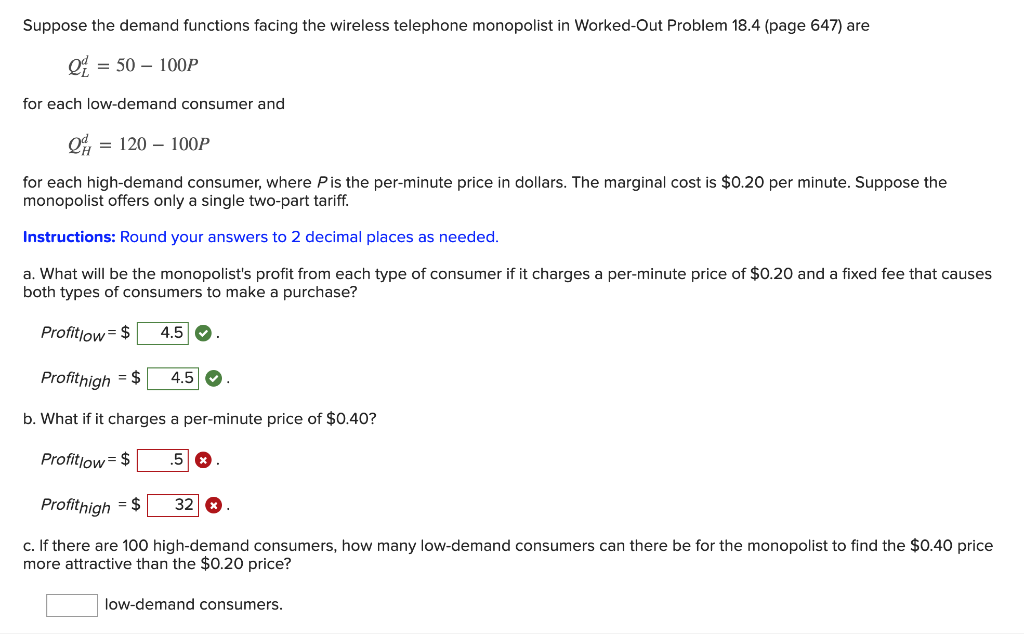Suppose the demand functions facing the wireless telephone monopolist in Worked-Out Problem 18.4 (page 647) are Q = 50 – 100P for each low-demand consumer and = 120 – 100P for each high-demand consumer, where Pis the per-minute price in dollars. The marginal cost is $0.20 per minute. Suppose the monopolist offers only a single two-part tariff. Instructions: Round your answers to 2 decimal places as needed. a. What will be the monopolist's profit from each type of consumer if it charges a per-minute price of $0.20 and a fixed fee that causes both types of consumers to make a purchase? Profitlow= $ 4.5 Profithigh = $ 4.5 b. What if it charges a per-minute price of $0.40? Profitiow= $ .5 Profithigh = $ 32 8 c. If there are 100 high-demand consumers, how many low-demand consumers can there be for the monopolist to find the $0.40 price more attractive than the $0.20 price? low-demand consumers.
Suppose the demand functions facing the wireless telephone monopolist in Worked-Out Problem 18.4 (page 647) are Q = 50 – 100P for each low-demand consumer and = 120 – 100P for each high-demand consumer, where Pis the per-minute price in dollars. The marginal cost is $0.20 per minute. Suppose the monopolist offers only a single two-part tariff. Instructions: Round your answers to 2 decimal places as needed. a. What will be the monopolist's profit from each type of consumer if it charges a per-minute price of $0.20 and a fixed fee that causes both types of consumers to make a purchase? Profitlow= $ 4.5 Profithigh = $ 4.5 b. What if it charges a per-minute price of $0.40? Profitiow= $ .5 Profithigh = $ 32 8 c. If there are 100 high-demand consumers, how many low-demand consumers can there be for the monopolist to find the $0.40 price more attractive than the $0.20 price? low-demand consumers.
Chapter14: Monopoly
Section: Chapter Questions
Problem 14.6P
Related questions
Question

Transcribed Image Text:Suppose the demand functions facing the wireless telephone monopolist in Worked-Out Problem 18.4 (page 647) are
= 50 – 100P
for each low-demand consumer and
= 120 – 100P
for each high-demand consumer, where Pis the per-minute price in dollars. The marginal cost is $0.20 per minute. Suppose the
monopolist offers only a single two-part tariff.
Instructions: Round your answers to 2 decimal places as needed.
a. What will be the monopolist's profit from each type of consumer if it charges a per-minute price of $0.20 and a fixed fee that causes
both types of consumers to make a purchase?
Profitlow= $
4.5 O
Profithigh = $
4.5
b. What if it charges a per-minute price of $0.40?
Profitlow= $
.5
Profithigh = $
32 &
c. If there are 100 high-demand consumers, how many low-demand consumers can there be for the monopolist to find the $0.40 price
more attractive than the $0.20 price?
low-demand consumers.
Expert Solution
This question has been solved!
Explore an expertly crafted, step-by-step solution for a thorough understanding of key concepts.
This is a popular solution!
Trending now
This is a popular solution!
Step by step
Solved in 4 steps

Knowledge Booster
Learn more about
Need a deep-dive on the concept behind this application? Look no further. Learn more about this topic, economics and related others by exploring similar questions and additional content below.Recommended textbooks for you









Managerial Economics: A Problem Solving Approach
Economics
ISBN:
9781337106665
Author:
Luke M. Froeb, Brian T. McCann, Michael R. Ward, Mike Shor
Publisher:
Cengage Learning